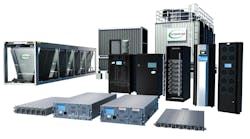Supermicro Unveils Data Center Building Blocks to Accelerate AI Factory Deployment
Key Highlights
- DCBBS combines servers, storage, cooling, power, networking, and management software into pre-validated, factory-tested bundles for rapid deployment.
- Supports multi-vendor AI architectures, including NVIDIA, AMD, and Intel, with high-efficiency liquid cooling solutions up to 250 kW per in-rack CDU.
- Includes lifecycle management tools like SuperCloud Composer and Automation Center to streamline operations and reduce time-to-first-model.
- Factory-level validation minimizes on-site integration risks, enabling faster, more reliable data center buildouts.
- Designed to support high-density, liquid-cooled GPU complexes such as NVIDIA’s NVL72, facilitating AI factory scalability and efficiency.
Supermicro has introduced a new business line, Data Center Building Block Solutions (DCBBS), expanding its modular approach to data center development. The offering packages servers, storage, liquid-cooling infrastructure, networking, power shelves and battery backup units (BBUs), DCIM and automation software, and on-site services into pre-validated, factory-tested bundles designed to accelerate time-to-online (TTO) and improve long-term serviceability.
This move represents a significant step beyond traditional rack integration; a shift toward a one-stop, data-center-scale platform aimed squarely at the hyperscale and AI factory market. By providing a single point of accountability across IT, power, and thermal domains, Supermicro’s model enables faster deployments and reduces integration risk—the modern equivalent of a “single throat to choke” for data center operators racing to bring GB200/NVL72-class racks online.
What’s New in DCBBS
DCBBS extends Supermicro’s modular design philosophy to an integrated catalog of facility-adjacent building blocks, not just IT nodes. By including critical supporting infrastructure—cooling, power, networking, and lifecycle software—the platform helps operators bring new capacity online more quickly and predictably.
According to Supermicro, DCBBS encompasses:
-
Multi-vendor AI system support: Compatibility with NVIDIA, AMD, and Intel architectures, featuring Supermicro-designed cold plates that dissipate up to 98% of component-level heat.
-
In-rack liquid-cooling designs: Coolant distribution manifolds (CDMs) and CDUs rated up to 250 kW, supporting 45 °C liquids, alongside rear-door heat exchangers, 800 GbE switches (51.2 Tb/s), 33 kW power shelves, and 48 V battery backup units.
-
Liquid-to-Air (L2A) sidecars: Each row can reject up to 200 kW of heat without modifying existing building hydronics—an especially practical design for air-to-liquid retrofits.
-
Automation and management software:
-
SuperCloud Composer for rack-scale and liquid-cooling lifecycle management
-
SuperCloud Automation Center for firmware, OS, Kubernetes, and AI pipeline enablement
-
Developer Experience Console for self-service workflows and orchestration
-
-
End-to-end services: Design, validation, and on-site deployment options—including four-hour response service levels—for both greenfield builds and air-to-liquid conversions.
-
Factory-level testing: Complete cluster-scale validation performed prior to shipment ensures minimal on-site integration risk. These are, in effect, data center building blocks ready to be deployed directly to the site.
Supermicro positions DCBBS as the industry’s first comprehensive, one-stop platform for data-center-scale buildout; focused on reducing time-to-online (TTO), improving performance, and lowering total cost. The company also cites up to 40% facility power reduction when using its liquid-cooling infrastructure compared with traditional air-cooled environments.
What’s the Importance to AI Deployment?
DCBBS represents a major evolution beyond traditional rack or bill-of-materials integration. Supermicro is now producing and selling data-center-scale building blocks—thermal, power, cabling, and orchestration systems—rather than just servers.
Modern AI factories, as defined by NVIDIA, revolve around rack-scale, liquid-cooled GPU complexes such as the NVIDIA GB200 NVL72: a single 72-GPU NVLink “domain” that functions as one massive accelerator. These architectures demand high-temperature liquid loops, dense power distribution, and ultra-low-latency 800 GbE or InfiniBand fabrics. Those are precisely the vectors that DCBBS productizes, integrating CDUs, CDMs, RDHx units, L2A sidecars, 800 GbE switching, power shelves, BBUs, and the software to monitor and automate them.
Because Supermicro already ships NVL72 and Blackwell systems at scale, DCBBS formalizes the surrounding facility kit and services: providing leak detection, power and thermal telemetry, and workflow automation straight out of the box. The expertise gained from years of delivering NVIDIA systems now extends to the supporting infrastructure, shifting the burden away from customers who once had to “mix and match” components to build AI-ready environments.
Charles Liang, president and CEO of Supermicro, explains:
With our expertise in delivering solutions to some of the largest data center operators in the world, we realized that supplying a complete IT infrastructure solution will benefit many organizations seeking to simplify their data center buildout. Our global manufacturing staff is prepared to collaborate with customers on their specific data center needs and deliver all of the necessary IT components for a modern, energy-efficient data center, including complete data center management software. With this new business line, we now offer services to expedite the construction and buildout of complete data centers. Our liquid-cooling options are designed and optimized specifically for the latest generation of GPUs, CPUs, and other electronics. These technologies can cut data center power consumption by up to 40% when using the Supermicro liquid-cooling infrastructure components, compared to existing air-cooled data centers.
Architectural Highlights for AI-Scale Deployment
According to Supermicro, the DCBBS architecture leverages the company’s data center integration experience while directly addressing power and cooling challenges uncovered in early AI factory deployments. Each subsystem has been refined to shorten deployment cycles and improve operational reliability.
Key architectural elements include:
-
Liquid-Cooling Building Blocks
CDUs rated up to 250 kW and Liquid-to-Air (L2A) sidecars (200 kW) give operators flexibility, either tying into existing building loops or deploying contained circuits for faster retrofits. The 45 °C liquid specification supports high-temperature water strategies for extended free-cooling hours. Each in-row CDU can manage up to 1.8 MW of server heat load. -
Power Resilience at the Rack
48 V battery backup shelves (33 kW for 90 seconds) enable software checkpointing rather than full restarts during grid disturbances, critical for multi-day training runs involving trillion-parameter models. -
Network and Cabling Design-as-a-Service
Integrated 800 GbE (51.2 Tb/s) topologies with optimized routing, port maps, and cable lengths reduce time-to-online (TTO) and field-integration errors—an often underappreciated source of schedule risk at scale. -
Lifecycle Control Plane
SuperCloud Composer provides unified visibility across servers, switches, PDUs, CDUs, and cooling towers, including leak detection and alerting. SuperCloud Automation Center (SCAC) delivers pre-packaged automation for firmware, OS, Kubernetes, and AI pipeline deployment, shortening time-to-first-model. -
Factory-Level Validation
Pre-assembled and cluster-tested builds are validated at data-center scale prior to shipment, minimizing on-site integration issues during critical path construction.
Industry Impact and Competitive Implications
NVIDIA’s AI factory model depends on rack-scale, liquid-cooled GPU complexes such as the NVL72. Supermicro’s DCBBS directly reduces the “facilities friction” required to deploy those systems, providing NVIDIA ecosystem customers with a single point of accountability across IT, liquid cooling, power shelves, BBUs, and orchestration. The result is particularly appealing for enterprises and mid-tier cloud operators that lack the vendor management depth of hyperscalers.
By standardizing and accelerating deployment of NVL72 and GB200-class racks, DCBBS shortens time-to-production and de-risks liquid cooling at extreme density. It serves as the connective tissue (rack-plus-facility glue with lifecycle software) that translates GPU clusters into operational AI capacity.
The launch also places competitive pressure on other OEMs and integrators to follow suit with facility-aware product lines and software-defined power and cooling frameworks. Expect to see more CDU, CDM, and RDHx SKUs, pre-cabled 800 GbE/InfiniBand topologies, and full cluster-level pre-validation become table stakes for next-generation offerings, particularly if Supermicro gains early traction with DCBBS.
Supermicro positions DCBBS squarely around time-to-online (TTO) reduction. By delivering factory-tested clusters, complete cabling documentation, and coordinated on-site build services, the company claims to shrink integration time dramatically. For teams deploying dozens of NVL72 racks, saving just days per row compounds to months of acceleration.
The ability to source pre-validated AI clusters along with liquid, power, and network infrastructure from a single vendor marks a meaningful alternative to multi-vendor orchestration, especially where schedule and density are the ultimate constraints.
Continuing Momentum: Supermicro Broadens the AI Factory Ecosystem
Supermicro’s launch of Data Center Building Block Solutions (DCBBS) arrives amid a steady drumbeat of complementary announcements that reinforce the company’s positioning as a turnkey supplier for AI-era infrastructure, from liquid-cooled Blackwell systems to dense multi-node blades for cloud service providers.
Volume Shipments of NVIDIA Blackwell Ultra
In September 2025, Supermicro began volume shipments of its NVIDIA Blackwell Ultra systems, including the HGX B300 and GB300 NVL72. The company emphasized “plug-and-play” deployment at the system, rack, and data-center scale: a practical demonstration of DCBBS principles.
Each configuration is pre-validated for power delivery, cooling, and network topology, enabling day-one operation. Supermicro now offers more than ten Blackwell and Blackwell Ultra SKUs engineered for AI factories of every scale, integrating direct liquid cooling (DLC-2) and 800 Gb/s fabrics. These systems show how DCBBS extends beyond integration services to an industrialized supply chain for AI factories.
Expanding the Blackwell Portfolio with DLC-2 and Front I/O Designs
August 2025 saw the debut of new 4U DLC-2 liquid-cooled and 8U front I/O air-cooled systems built on NVIDIA HGX B200. Both models target large-scale AI training and inference deployments while simplifying cabling and serviceability from the cold aisle.
The 4U DLC-2 system delivers up to 40 percent power savings and 98 percent heat capture, using 45 °C warm-water cooling to extend free-cooling hours. The 8U air-cooled variant provides an optimized choice for facilities without liquid infrastructure. Together, they underscore Supermicro’s intent to standardize modular cooling architectures: a central theme also embodied in DCBBS.
Partnership with Lambda and Cologix
That same month, Supermicro and Lambda—the self-styled Superintelligence Cloud—announced new AI factories deployed at Cologix’s COL4 Scalelogix data center in Columbus, Ohio. Lambda’s clusters, integrating Supermicro’s NVIDIA Blackwell and Hopper-based systems, demonstrate how DCBBS-aligned rack-scale packages can translate directly into production AI capacity.
The partnership illustrates how energy-efficient cooling and rapid deployment models are migrating from hyperscale to enterprise and regional colocation markets.
New 6U MicroBlade with AMD EPYC 4005
Rounding out the series, October 2025 brought the 6U 20-node MicroBlade, powered by AMD’s EPYC 4005 series. Delivering 3.3× higher density than traditional 1U servers, with up to 160 servers per 48U rack, this design targets cloud and hosting providers seeking green, high-density compute. With Titanium-level PSUs, integrated Ethernet switching, and unified remote management, the MicroBlade applies the same building-block efficiency philosophy to lower-power, edge, and inference workloads.
A Converging Vision
Taken together, these announcements reveal a consistent engineering doctrine: Supermicro is evolving from a server manufacturer into a data-center-scale platform integrator. Whether through DCBBS, Blackwell Ultra rack systems, DLC-2 liquid-cooling architectures, or AMD-based MicroBlades, each initiative aligns around factory-validated modularity, liquid-readiness, and compressed time-to-online.
For data center operators navigating the AI industrial revolution, that coherence signals more than a product roadmap. It points to an emerging ecosystem template for standardized AI factory deployment.
At Data Center Frontier, we talk the industry talk and walk the industry walk. In that spirit, DCF Staff members may occasionally use AI tools to assist with content. Elements of this article were created with help from OpenAI's GPT5.
Keep pace with the fast-moving world of data centers and cloud computing by connecting with Data Center Frontier on LinkedIn, following us on X/Twitter and Facebook, as well as on BlueSky, and signing up for our weekly newsletters using the form below.
About the Author

David Chernicoff
Matt Vincent
A B2B technology journalist and editor with more than two decades of experience, Matt Vincent is Editor in Chief of Data Center Frontier.



